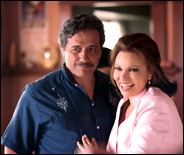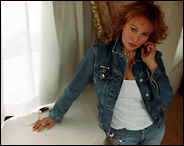|
 |
|
Esta página no está disponible en español. THE NEW YORK TIMESRaquel Welch Is Reinvented As A LatinaBy MIREYA NAVARRO
June 11, 2002
Edward James Olmos plays Jess Gonzalez and Raquel Welch [PHOTOS: Susana Raab for The New York Times] ---------- In "American Family," the PBS television series about a Mexican-American family in East Los Angeles, now in its first season, Aunt Dora is the drama queen of the family, a passionate, romantic woman who might have become a Hollywood star had she vigorously pursued her acting career. The actress playing Aunt Dora is Raquel Welch, who infuses the role with her familiar sultriness and smoky voice. Nevertheless the sight of Ms. Welch in that role might bewilder some fans who remember her best for films like "Fantastic Voyage," "One Million Years B.C.," "Kansas City Bomber" and "The Four Musketeers," as "Woman of the Year" on Broadway and in nightclub acts in Las Vegas. Dora, you see, is a Latina, a title Ms. Welch herself is claiming for the first time after nearly 40 years in show business. "I'm happy to acknowledge it and it's long overdue and it's very welcome," she said in a recent interview at the Watergate Hotel in Washington. "There's been kind of an empty place here in my heart and also in my work for a long, long time." Jo-Raquel Tejada, born in Chicago of a Bolivian father and an American mother, is taking to her heritage with gusto. Not only is she playing Dora as well as the film role of Hortensia in the 2001 romantic farce "Tortilla Soup," she is also strutting her ethnicity in events like the American Latino Media Arts Awards and other public appearances. "Latinos are here to stay," she told her audience at a National Press Club luncheon last month. "As citizen Raquel, I'm proud to be Latina." As both citizen Raquel and Raquel Welch, sex symbol and pinup girl, Ms. Welch has bridged two eras. She has worked in the Hollywood that made her a blonde and tried to take away her first name as well as in the Hollywood that now considers Latinos hip and pays Jennifer Lopez up to $12 million a picture. Ms. Welch grew up with a father who tried to assimilate at all costs, even banning Spanish at home. But now, at 61, she is riding the wave of new Latino generations that flaunt their ethnic pride and behave with the confidence of a major demographic force. These days Ms. Welch is learning Spanish from tapes, planning her first trip to Bolivia in August to meet relatives and working on her own Latino film project. After fifty-some movies and worldwide celebrity, she is embracing the identity she said she had to reject to break into film. "It was told to me that if I wanted to be typecast, I would play into that," she said, by emphasizing her Hispanic background. "You just couldn't be too different. My first big breakthrough part in `One Million Years B.C.' they died my hair blond. It's a marketing thing. And now I'm sure there are a lot of people who are marketing specialists just for the Latino community. They want those 35 million people to buy their products and to vote for them." Today, some people note, there is still plenty of casting of Latino actors as non-Latinos. Felix Sanchez, president of the National Hispanic Foundation for the Arts in Washington, an advocacy group for Hispanics in entertainment, said the message to many actors still was that they had to eliminate ethnicity to succeed. "They're able to be ethnically present to the Latino audience but ethnically invisible to a majority audience," Mr. Sanchez said. "That's the comfort level of film and television today. We need to move it beyond that to where our culture and identity are fully integrated in a character." But others argued that for every Martin Sheen or Cameron Diaz, actors of Spanish and Latin descent who usually portray non-Latin characters, there is an Esai Morales or Andy Garcia, who play Latino characters or alternate ethnic roles. "We can have Latino actors play Latinos or non-Latinos — it doesn't matter," said Luis Reyes, co-author of "Hispanics in Hollywood: A Celebration of 100 Years in Film and Television" (Lone Eagle, 2000). "We just need a diversity of images. If you have diversity, at least the negative images don't bother you because that's not all you see." That Ms. Welch feels comfortable calling herself Latina and has found solid Latina roles to play reflect fundamental changes in Hollywood. Latinos have been part of motion pictures since the industry's inception, but their depiction in movies has fluctuated wildly, from amoral bandits to aristocratic Latin lovers, for instance, depending on the politics and events of the time, film historians say. Some portrayals were so offensive that in the 1920's Mexico and other Latin American countries called for a boycott of American films. But there were also periods when Latinos were popular — the Latin lover craze, the Carmen Miranda comedies — particularly in World War II when much of Europe was closed off as a market and movies turned to Latin America instead. For many Latino actors, success depended on fitting the all-American mold. There was Rita Hayworth, the sex symbol of the 1940's who in real life was Margarita Carmen Cansino, born to a Spanish father and an Irish mother. And there was Anthony Rudolph Oaxaca Quinn, born in Chihuahua, Mexico, of Mexican-Indian and Mexican-Irish parents, and better known as Anthony Quinn. "He had to be somewhat Anglo or European in order not to be dismissed," Ms. Welch said Quinn told her when they discussed the subject before his death last year. In her own case, Ms. Welch gave in on the hair but not on Raquel, her paternal grandmother's name. (Welch was her first husband's name.) "I thought, well, if I can't even have the Raquel, that's really selling out completely, that's really turning my back on everything that I really am," she said. She played a Latina in only two movies, a Mexican in "Bandolero!" and a Mexican Yaqui Indian in "100 Rifles," in which she is better remembered for her interracial love scenes with Jim Brown. Ms. Welch said she never hid her ethnic background, but it never became common knowledge. Instead, she wore a fur bikini and was typecast as a sex symbol. Then again, for Ms. Welch, who grew up in La Jolla and San Diego, playing a Latina would have been more of a departure than playing a glamorous bombshell. She said her father was dead set on raising his three children as American as apple pie. An ambitious immigrant who came to the United States from Bolivia to study engineering, Armando Carlos Tejada never looked back. Ms. Welch said her family never visited Bolivia. And it was not until her 30's, when her grandmother came for a visit, that Ms. Welch finally met her namesake. "Those people who wanted to make it in the American system found it necessary and desirable to kind of suppress their Latino quality," she said of her father. "He never spoke any Spanish in the home, so as not to have us have an accent. We never were in a neighborhood where there were other Latinos around. I didn't know any Latin people." For a long time, she said, she resented her father for what she calls overkill. She said his effort to erase his ethnicity was "a lie, a lie that worked as far as blending in." But eventually she came to understand him. "In a way he didn't have a choice," she said. "There was a sense of shame on his part, of the confusion and the prejudice around against Latins," Ms. Welch said. "So he suffered a great deal. I suffered some. My suffering is more of a kind of psychological feeling of not knowing who I am." But the Mexican-American director and writer Gregory Nava ("El Norte," "Mi Familia," "Selena"), who grew up in San Diego, said he knew about Raquel Tejada. As a boy he remembered her winning the title Fairest of the Fair at the San Diego County Fair, part of a pageant trifecta in 1958 in which she also won Miss La Jolla and Maid of California. "She was the most beautiful girl in town," Mr. Nava said. "The whole Latino community was very proud of her." When the time came to cast Dora for "American Family," a character based on one of Mr. Nava's aunts, he needed an actress who was not only beautiful but also charismatic. Mr. Nava, 53, decided to take Ms. Welch out to dinner and ask her to play Dora. "She said, it's too late for me to be Latina," he recalled. "I said, it's never too late." On the series, alongside actors like Edward James Olmos, Sonia Braga and Esai Morales, "she's totally believable," Mr. Nava said. "Obviously, it's there," he said of her Latina essence. Mr. Reyes, the writer, says Ms. Welch has nothing to lose by taking Latina roles. "She's 60 years old, and how many roles are there for 60-year-old women?" he said. But while Ms. Welch, who can still wear tight jeans and a low cut T-shirt, may be finding new roles in her current incarnation, she said she had not been showered with offers. Despite signs of a more auspicious climate for Latinos in Hollywood, they are still largely absent from movies and prime-time television. Ms. Welch has developed her own wig and beauty product lines. She has a son, Damon James Welch, a computer consultant and aspiring actor, and a daughter, the actress Tahnee Welch. Richard Palmer, a restaurateur, is her fourth husband, and they live in Beverly Hills. "I do feel very fortunate now at this point in my career, where I'm definitely middle aged and I'm not getting the kind of young leading lady parts anymore, that I have discovered and have been gifted with this role on `American Family' where I can feed myself personally as a human being," she said. On the set of this other American family, she said, "I feel completely like I belong."
|

 ----------
----------